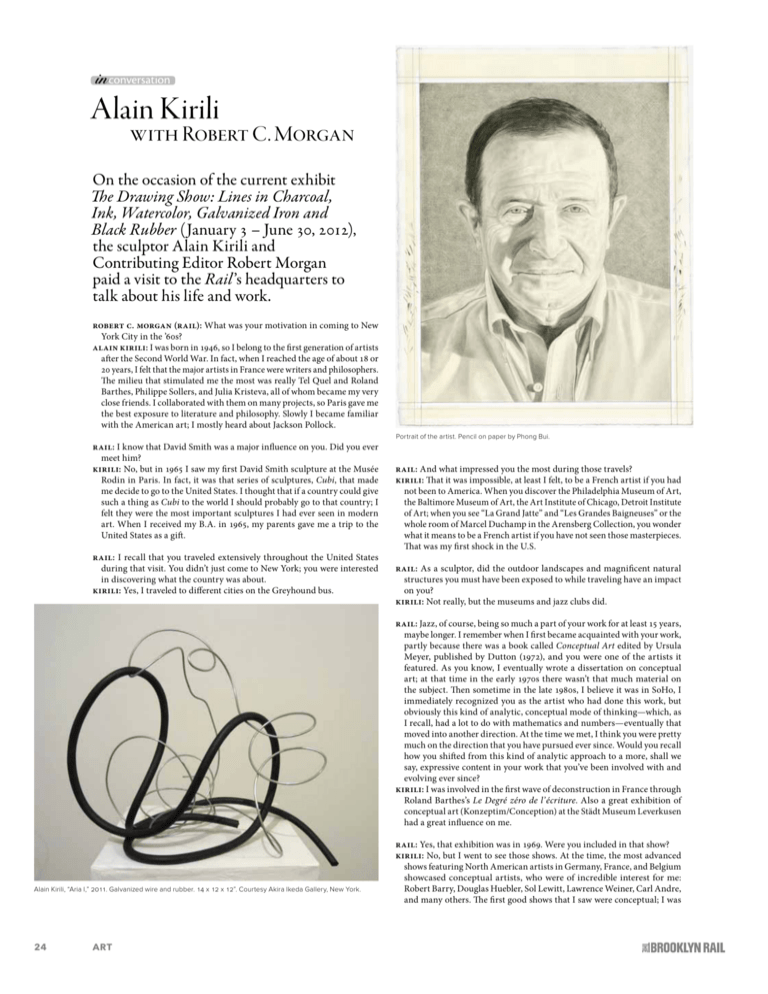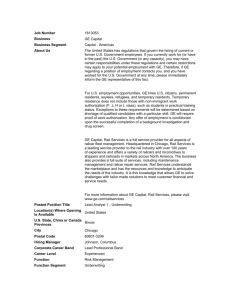Alain Kirili
advertisement

Alain Kirili with Robert C. Morgan On the occasion of the current exhibit The Drawing Show: Lines in Charcoal, Ink, Watercolor, Galvanized Iron and Black Rubber (January 3 – June 30, 2012), the sculptor Alain Kirili and Contributing Editor Robert Morgan paid a visit to the Rail’s headquarters to talk about his life and work. Robert C. Morgan (Rail): What was your motivation in coming to New York City in the ’60s? Alain Kirili: I was born in 1946, so I belong to the first generation of artists after the Second World War. In fact, when I reached the age of about 18 or 20 years, I felt that the major artists in France were writers and philosophers. The milieu that stimulated me the most was really Tel Quel and Roland Barthes, Philippe Sollers, and Julia Kristeva, all of whom became my very close friends. I collaborated with them on many projects, so Paris gave me the best exposure to literature and philosophy. Slowly I became familiar with the American art; I mostly heard about Jackson Pollock. Rail: I know that David Smith was a major influence on you. Did you ever meet him? Kirili: No, but in 1965 I saw my first David Smith sculpture at the Musée Rodin in Paris. In fact, it was that series of sculptures, Cubi, that made me decide to go to the United States. I thought that if a country could give such a thing as Cubi to the world I should probably go to that country; I felt they were the most important sculptures I had ever seen in modern art. When I received my B.A. in 1965, my parents gave me a trip to the United States as a gift. Rail: I recall that you traveled extensively throughout the United States during that visit. You didn’t just come to New York; you were interested in discovering what the country was about. Kirili: Yes, I traveled to different cities on the Greyhound bus. Portrait of the artist. Pencil on paper by Phong Bui. Rail: And what impressed you the most during those travels? Kirili: That it was impossible, at least I felt, to be a French artist if you had not been to America. When you discover the Philadelphia Museum of Art, the Baltimore Museum of Art, the Art Institute of Chicago, Detroit Institute of Art; when you see “La Grand Jatte” and “Les Grandes Baigneuses” or the whole room of Marcel Duchamp in the Arensberg Collection, you wonder what it means to be a French artist if you have not seen those masterpieces. That was my first shock in the U.S. Rail: As a sculptor, did the outdoor landscapes and magnificent natural structures you must have been exposed to while traveling have an impact on you? Kirili: Not really, but the museums and jazz clubs did. Rail: Jazz, of course, being so much a part of your work for at least 15 years, maybe longer. I remember when I first became acquainted with your work, partly because there was a book called Conceptual Art edited by Ursula Meyer, published by Dutton (1972), and you were one of the artists it featured. As you know, I eventually wrote a dissertation on conceptual art; at that time in the early 1970s there wasn’t that much material on the subject. Then sometime in the late 1980s, I believe it was in SoHo, I immediately recognized you as the artist who had done this work, but obviously this kind of analytic, conceptual mode of thinking—which, as I recall, had a lot to do with mathematics and numbers—eventually that moved into another direction. At the time we met, I think you were pretty much on the direction that you have pursued ever since. Would you recall how you shifted from this kind of analytic approach to a more, shall we say, expressive content in your work that you’ve been involved with and evolving ever since? Kirili: I was involved in the first wave of deconstruction in France through Roland Barthes’s Le Degré zéro de l’écriture. Also a great exhibition of conceptual art (Konzeptim/Conception) at the Städt Museum Leverkusen had a great influence on me. Alain Kirili, “Aria I,” 2011. Galvanized wire and rubber. 14 x 12 x 12”. Courtesy Akira Ikeda Gallery, New York. 24 ART Rail: Yes, that exhibition was in 1969. Were you included in that show? Kirili: No, but I went to see those shows. At the time, the most advanced shows featuring North American artists in Germany, France, and Belgium showcased conceptual artists, who were of incredible interest for me: Robert Barry, Douglas Huebler, Sol Lewitt, Lawrence Weiner, Carl Andre, and many others. The first good shows that I saw were conceptual; I was Steve Lacy, 1999. Photo: Ariane Lopez-Huici. Joe McPhee in front of “Commandment” drawing series by Alain Kirili at Akira Ikeda Gallery/NY 2012. Photo: Takuma Kanaiwa. interested in this idea of deconstruction, but suddenly I felt I could not survive if I did not have tactility. I could not be satisfied only with a conceptual approach to art. I needed incarnation. I discovered that conceptual art was actually a puritanical approach. The de-materialization of art was too prudish for me. My first reaction was to just take a piece of clay and model it in an abstract way, which was reproduced later in the catalog of my first show at Ileana Sonnabend in New York in 1978. Rail: When you were working with clay, were you thinking in terms of form and tactility? Kirili: Yes. Rail: There was no vessel or anything like that, it was just a kind of expressive gesture? Kirili: There was no narrative whatsoever. It was a world of tactility. I slowly started to understand the relationship of the body with sensuality, sexuality, which were and still are very important to me. I could not survive without those elements. Rail: Again, you began with an analytic idea in relation to conceptual art, which paralleled your interest in Writing Degree Zero, in order to develop a “conceptual: visual/ numerical counterpart.” Then, later in the process, you discovered the expressive power in revealing the touch within the material, which you felt was a natural transition in your work. And by working abstractly with terra cotta what were the things that occurred to you at the time? Kirili: I gained a greater understanding and deep appreciation of the beauty of the gesture in art. I then began to use very old techniques alongside blacksmithing and modeling in clay. Rail: And then you moved from terra cotta to metal? Kirili: I was working on both mediums simultaneously. In fact, they complement each other. I also have studied calligraphy with Korean artist Lee Ungno. Later I was able to translate those calligraphic gestures into blacksmithing and clay modeling. I perceive myself, in some ways, as a calligraphic sculptor. Rail: The linear aspect of your work is still very present in both the drawings and sculptures in your current exhibition at Akira Ikeda. There is a calligraphic measure in relation to an expressive content. This was also true with your work in forging. I wanted to mention forging and ask when you started working with iron. Kirili: I started with abstract clay in the early ’70s, but then the forging came a couple of years later. Actually, I exhibited MAY 2O12 my first forging piece at the inauguration of PS1 in ’76. Rail: Then you developed the practice of placing the sculpture on the floor in a series of forged iron works, all approximately the same size, which was the beginning of what later became the Commandment series. Kirili: That’s right. The first “Commandment,” which is in the Ludwig collection in Germany, is from 1980. The piece, which is comprised of 15 individual units, uses the floor as a support; the units were placed on and off the grid, asserting different calligraphic gestures, yet they all articulated the unity of the sound and movement of the wall. Although when I did the first “Commandment,” it gained enormous complexity. It became a piece that went beyond what I could even comprehend as I made it. It took me quite a long time to find a title for it. I found “Commandment” when I visited the Jewish Museum in New York and saw pieces called rimonim, Torah finials. There were many of them in the window; they were somewhat similar to my iron sign. I was so impressed with the connection that I went to visit a rabbi on White Street to ask him why the objects were named rimonim, and he told me it was the Hebrew word for pomegranate; they were so named because there are as many seeds in pomegranates as there are commandments in the Torah. Rail: The point is that just because something ascends upward it is not necessarily transcendent. In the ’80s, a lot of artists became concerned with the ground and the perceptual field in relation to the writings of MerleauPonty, and I think the Commandments relate to that. Also, there are other works produced as aggregates or multiple forms that also rise up from the ground. For example, I’ve seen installations of yours in ecclesiastical environments in Europe. One appears on the cover of the Flammarion book I published on your work in 2002. There is a field of columns as opposed to a singular form stationary on the ground. What is your idea about that kind of multiplicity where you have columns that in some way relate to the work of Barnett Newman who was interested in relating to the standing figure? Kirili: I spoke earlier about how crucial the body incarnate was to me; it is true that I feel tactility to be necessary, but there’s something else I can’t resist: my profound love of verticality. Anything that is too much on the ground depresses me. I need verticality; it’s part of my means of survival, of my dignity even. It’s true that paintings in prehistoric caves were among the first marks of creation, but the earliest people also erected vertically raised stones, weighing 15, 20 tons. Left to right: William Parker, Thomas Buckner, Maria Mitchell, 1998. Photo: Ariane Lopez-Huici. Rail: The menhirs. Kirili: Yes. Those were very important celebrations of human life and its dignity. Enormous weight was applied to pull them vertically, so their creators were very invested in the idea of the vertical. But the vertical I am concerned with is a vertical around which you can turn. There is an old mystery, for which I can provide no explanation, about why there is pattern of circumvolution in art and religion; it’s something that seems to occur naturally in humanity. The human being will circumvent around a verticality, around a church in procession. There is circumvolution with the Torah in the synagogue: inside the synagogue they turn with the Torah so that everyone kisses. Circumvolution, verticality, and tactility are fundamental drives in each human—and in my art, too. I would like to mention Barnett Newman because I saw him very early at the Guggenheim; The Stations of the Cross exhibition in 1966 was very important for me. Then in ’71, at the Grand Palais in Paris, I saw the complete retrospective, organized by Thomas Hess. I wanted to meet Thomas Hess, so I went back to the U.S. We had lunch together and built a friendship over conversations about verticality, particularly verticality in Barnett Newman’s work, in his painting as well as in his sculpture. Because Hess was also a collector of Alberto Giacometti sculptures, we had the most fabulous conversations in which we compared the zip and the sculpture of Newman with those of Giacometti. Newman and Giacometti are the two poles of my work. Those poles built my Franco-American identity: the fragility of Giacometti and the affirmation of Newman. The idea of sublimation also interests me very much. Two beautiful pieces made in the 20th century— “Pithecanthropus Erectus” by the bassist Charlie Mingus and “Vir Heroicus Sublimus” by Barnett Newman—were a real inspiration for me. They’re two extraordinary titles. Rail: One of the stories you mentioned when I visited the Akira Ikeda Gallery a few weeks ago was that you had to convince Mr. Akira Ikeda that your recent wire and rubber pieces were in fact drawings in three-dimensional space. I wonder if you could talk a little more about this. Kirili: I didn’t have much convincing to do, but he did not anticipate that wire was a way to draw in space. I like the instant quality I find in charcoal. I use wire like the way I draw with ink; if I use galvanized wire, I have a reflection that creates a dialectic with the black rubber which mats and absorbs the light. The wire takes shape and rubber becomes supported by the wire without shaping itself so much. ART 25 Alain Kirili, “Commandments, Series 1 of 6,” 1987. Charcoal on paper. 8.5 x 10.9”. Courtesy Akira Ikeda Gallery, New York. Alain Kirili, “Commandments, Series 2 of 6,” 1987. Charcoal on paper. 8.5 x 10.9”. Courtesy Akira Ikeda Gallery, New York. Alain Kirili, “Commandments, Series 3 of 6,” 1987. Charcoal on paper. 8.5 x 10.9”. Courtesy Akira Ikeda Gallery, New York. Alain Kirili, “Commandments, Series 4 of 6,”1987. Charcoal on paper. 8.5 x 10.9”. Courtesy Akira Ikeda Gallery, New York. Alain Kirili, “Commandments, Series 5 of 6,” 1987. Charcoal on paper. 8.5 x 10.9”. Courtesy Akira Ikeda Gallery, New York. Alain Kirili, “Commandments, Series 6 of 6,” 1987. Charcoal on paper. 8.5 x 10.9”. Courtesy Akira Ikeda Gallery, New York. Rail: When you’re talking about support, are you talking about visual, physical, or both? Kirili: Visual and physical. I had to do my best to convince Ikeda that wire is a way to be a calligrapher. Rail: In some of these forged aluminum columns that you’re speaking of, they’re shown as an ensemble. Kirili: Yes, but they can be individual too. Rail: I think we should speak about your great sustaining interest in jazz and the relationship you feel between jazz and your sculpture. This is something that you introduced me to many years ago, long before we did the book. I think we even talk about it in the interview from 1992, so it goes back a long time, and you’re still doing it. Can you make a few comments about the connections you see? Kirili: One of the major reasons I love to live in New York is because of the large presence of those saints, poets who are the improvisers of jazz. I say saints because their music is not about entertainment but spiritual experience. One of my first contacts in American art was Sidney Bechet, who came to play in the kitchen of my parents’ home when I was a child. He was very impressive for me, and gave me a sense that I wanted to go to America, especially to New York. Today I meet contemporary jazz musicians, the great masters of today who like to play with my sculptures and use them as partitions. Joe McPhee, Daniel Carter, Roy Campbell, Thomas Buckner, and Cecil Taylor are the ones who come regularly to my studio and like to interact with visual arts. It’s more than an interaction; it is a communion. There will be an evening at the current show at Akira Ikeda where my drawings will serve as a partition for a saxophone solo by Joe McPhee. New York has not only offered me an exchange with poets and writers, but with musicians and dancers. The African-American musicians give in their creation an emotional and a spiritual dimension that I need to support my work. That’s why Ariane and myself militantly open our loft to free jazz musicians in order to create a dialogue. Rail: A week ago or so, I went to a concert at your loft which was a kind of homage to John Cage. I believe it would have been his 100th birthday. His former colleague, the composer Christian Wolff, was there, as well as the artist William Anastasi and a number of other people that were close to John Cage. I mentioned to you that from my vantage point, as I was looking at the wall behind the area in which they were performing and I saw another of these wire pieces, I was convinced that it was flat. And then after the concert, I had an occasion to move to the other side of the room, and suddenly I looked up and I saw this piece was projecting from the wall. The illusion was so convincing. And I find that an interesting part of your work because I think illusion is something that was kind of denied during the, shall we say, high Minimal period. There was a reluctance to deal with illusion in Minimal Art. I think that you’re bringing this kind of linear content into your art now in a more extreme way—more extreme than I’ve seen in your earlier work—except for the wire that you included in some of the terracottas in the ’70s. They’re the most complex bodies of works you have made in recent years. Which brings me to my next technical question regarding your vertical aluminum pieces from the early ’90s: I remember when you were describing the process to me when you first applied the torch to the aluminum you got this kind of explosion, almost like a floral mechanism of some sort. Kirili: There is a sort of explosion when you heat aluminum. Forging it was a kind of technical discovery; nobody ever forged aluminum before. So when I did the forging, I discovered the explosion, and found that it was a very expressionistic and emotional sign which emerged from the regularity of the vertical; the opposition was itself a beautiful, complex world. I was very pleased to develop that. 26 ART Rail: You mentioned David Smith’s Cubi series, which is his late work from ’65, ’66. During that period he was concerned with the base. From my point of view, he never really resolved the problem of the base. I’m wondering if the fact that your columns employ a support structure ever became an issue for you or if that is something that you simply accept. Kirili: It is something I accept. It’s an issue for me, because the base is not only a form of support, it also has a symbolic function. That is why I like the Yoni-Lingam, because the yoni is a female sex; the yoni and the lingam together represent Shiva. It’s a Shiva sign, but what is really extraordinary about the Yoni-Lingam, one of the great contributions of India, really, was to tell us that the base has a function as important as the vertical. I think it’s wonderful to think of the yoni as this feminine representation of the female sex. In ritual, priests often drop water (or yogurt, milk, or other liquids) into it; everything would go into its canal. The Yoni-Lingam is a very sexualized sphere. Rail: So, this informs your idea of the base in relation to the vertical columns? Kirili: It reinforced what I already did before I discovered Yoni-Lingam, but the base is very important. In the aluminum sculpture I used a base of hot iron to make a contrast between the two metals. Generally, all of my bases have a formal and symbolic function. What has been extremely important to me as far as the relationship between sexuality and spirituality—something crucial in my work—is that in India, among Shaivites, they are very aware of the importance of Catholicism. They know that the Church of France and Italy is as important as their own temples: Chartres is on par with Tanjore.








